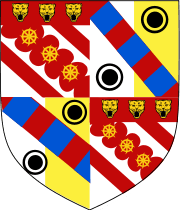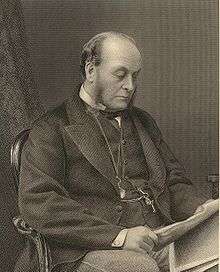Earl of Cranbrook
Earl of Cranbrook, in the County of Kent, is a title in the Peerage of the United Kingdom.[1] The family seat is Great Glemham House, near Saxmundham, Suffolk.
| Earl of Cranbrook | |
|---|---|
 Arms of the Earl of Cranbrook Arms: Quarterly: 1st & 4th, Argent, on a Bend invected, plain cotised Gules, three Catherine Wheels Or, on a Chief Gules, three Leopard’s Faces Or (Hardy); 2nd & 3rd, Per pale Argent and Or, a Bend compony Azure and Gules, between two Pellets, each within an Annulet Sable (Gathorne). Crests: 1st: a Dexter Arm embowed in armour proper, garnished Or, entwined with a Branch of Oak Vert, charged with two Catherine Wheels Gules, one above and one below the elbow, the hand grasping a Dragon’s Head erased proper (Hardy); 2nd: in front of a Wolf’s Head erased Argent, a Staff raguly fesswise Or (Gathorne). Supporters: On either side a Leopard guardant proper, gorged with a Collar Gules, pendant therefrom an Escutcheon Gules charged with a Catherine Wheel Or. | |
| Creation date | 22 August 1892 |
| Monarch | Queen Victoria |
| Peerage | Peerage of the United Kingdom |
| First holder | Gathorne Gathorne-Hardy, 1st Earl of Cranbrook |
| Present holder | Gathorne Gathorne-Hardy, 5th Earl of Cranbrook |
| Heir apparent | John Gathorne-Hardy, Lord Medway |
| Remainder to | the 1st Earl's heirs male of the body |
| Subsidiary titles | Viscount Cranbrook Baron Medway |
| Status | Extant |
| Motto | ARMÉ DE FOI HARDI (Armed with hardy faith) |
Creation and 1st Earl
It was created in 1892 for the prominent Conservative politician Gathorne Gathorne-Hardy, 1st Viscount Cranbrook. He notably held office as Home Secretary, Secretary of State for War and Secretary of State for India. Gathorne-Hardy had already been created Viscount Cranbrook, of Hemsted in the County of Kent, in 1878,[2] and was made Baron Medway, of Hemsted in the County of Kent, at the same time he was given the earldom. The latter title is used as a courtesy title for the Earl's eldest son and heir apparent.
Second earl
Lord Cranbrook's eldest son, the second Earl, represented Rye, Mid Kent and Medway in the House of Commons as a Conservative.
Fourth earl
John David Gathorne-Hardy, 4th Earl of Cranbrook (who was previously married to Bridget D’Oyly Carte). Second marriage to Fidelity (4), (born in 1912, JP), married on 26 July 1932 and had five children: Gathorne, 5th Earl of Cranbrook, 1933-; Hugh 1941-; Juliet 1934-; (Catherine) Sophia 1936-; Christina 1940-
Fifth and current earl
As of 2010 the titles are held by the latter's great-grandson, the fifth Earl, who succeeded his father in 1978. He is a zoologist and environmental biologist, who was awarded the Royal Geographical Society's Founder's Gold Medal in 1995.[3]
Other members of the family
Hon. Alfred Gathorne-Hardy, third son of the first Earl, sat as a Member of Parliament for Canterbury and East Grinstead. Another member of the family was the writer Jonathan Gathorne-Hardy, a son of Hon. Anthony Gathorne-Hardy, youngest son of the third Earl.
Earls of Cranbrook (1892)

- Gathorne Gathorne-Hardy, 1st Earl of Cranbrook (1814–1906)
- John Stewart Gathorne-Hardy, 2nd Earl of Cranbrook (1839–1911)
- Gathorne Gathorne-Hardy, 3rd Earl of Cranbrook (1870–1915)
- John David Gathorne-Hardy, 4th Earl of Cranbrook (1900–1978)
- Gathorne Gathorne-Hardy, 5th Earl of Cranbrook (b. 1933).
The heir apparent is the present holder's son John Jason Gathorne-Hardy, Lord Medway (b. 1968).
Line of succession
- John Jason Gathorne-Hardy, Lord Medway (b. 1968)
- Hon. Angus Edward Gathorne-Hardy (b. 1973), younger son of the 5th Earl
- Hon. Hugh Gathorne-Hardy (b. 1941), younger son of the 4th Earl
- Frederick Jasper Gathorne-Hardy (b. 1971), elder son of (3)
- Alfred Gathorne-Hardy (b. 1978), younger son of (3)
- Benjamin Garthorne-Hardy (b. 1967), great-grandson of the 3rd Earl by his youngest son Hon. Antony Gathorne Gathorne-Hardy (1907-1976) via Jonathan Gathorne-Hardy (1933-2019)
- Robert Dee Gathorne-Hardy (b. 1973), grandson of Antony Gathorne Gathorne-Hardy aforesaid via Samuel Gathorne Gathorne-Hardy (1936-2019)
Notes
- "No. 26326". The London Gazette. 16 September 1892. p. 5273.
- "No. 24578". The London Gazette. 3 May 1878. p. 2862.
- Brian G Gardiner, ed. (July 2006). "218th Anniversary Meeting of the Linnean Society ..." (PDF). The Linnean. 22 (3): 36. Archived from the original (PDF) on 2009-07-08.
References
- Kidd, Charles; Williamson, David, eds. (1990). Debrett's Peerage and Baronetage. Macmillan. ISBN 978-0-3333-8847-1.
- Leigh Rayment's Peerage Pages
External links
- Hansard 1803–2005: contributions in Parliament by Gathorne Gathorne-Hardy, 3rd Earl of Cranbrook
- Hansard 1803–2005: contributions in Parliament by John David Gathorne-Hardy, 4th Earl of Cranbrook
- Hansard 1803–2005: contributions in Parliament by Gathorne Gathorne-Hardy, 5th Earl of Cranbrook
